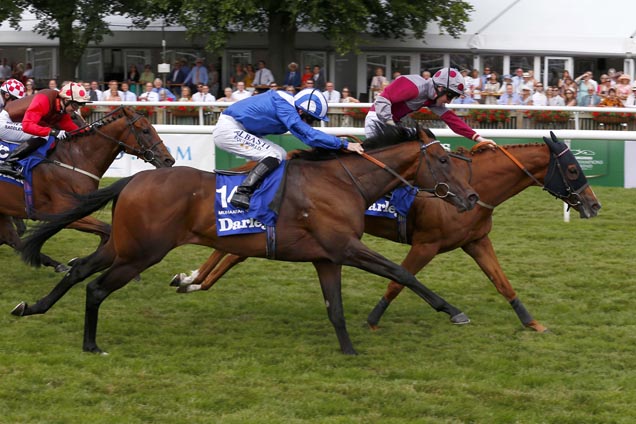3 minute read
It’s almost exactly a year since the European Pattern Committee revealed one of their boldest-ever initiatives for the 2015 Flat racing season.

Recognising the position of sprints as the poor relation in the European racing family, they instigated a new programme of sprints, with particular attention to those for three-year-olds, culminating in a new race, fast-tracked to Group 1 status, which came to be known as the Commonwealth Cup.
Quite how sprinting came to fall behind in European racing is impossible to pin down as its roots spread far and wide, from the long-time, belatedly acknowledged inaction of the EPC to the germinal moment when Vincent O’Brien spotted the promise in Northern Dancer’s progeny.
Whatever lies at the roots, the tree has spent 40-odd years growing and Europe is evidently way behind other major jurisdictions in terms of sprinters, as is amply demonstrated when the Australians or Japanese send their best. The diet is so loosely-defined that we don’t even have one definite championship race: no Derby, no QEII, no Arc that acts as a win-and-you’re-in to the annals of history.
It would admittedly be pretty unsatisfactory if in reality one race were to be elevated above the other big sprints, like reducing the Ashes to a single T20. Sprint races are particularly prone to flux, with interference, draw or quite literally a second’s hesitation from the jockey often enough to end a horse’s chance.
Even so, with the Haydock Sprint Cup on the horizon and the Prix de L’Abbaye and British Champions Sprint (also promoted to Group 1 level in last year’s re-shuffle) not far off, either, it feels like an opportune time to play Europe’s best sprints off against one another. We have enough historical data to make a statistically-meaningful measure of which races tend to produce the very best performances.
The Timeform Elves have turned that whim into hard reality, comparing the winning performances of 10 leading sprints in Europe (realistically, Britain and France) across this century so far. We’ve included some lesser Group races, with the perception being that sprinters, who race more and yet have fewer Group 1 opportunities, don’t leave the same gap in performance between the big days and the build-up days. The below graphic, with the 10 races presented in chronological order, was the result. As before, the ‘boxes’ give us an idea of strength (by their position) and variance (by width), while the thick black lines represent the median.

The first thing to notice is that the Group 2s and 3s are as far behind as their grading implies. Though many of the names on the Palace House’s roll of honour might be shared with the Nunthorpe or King’s Stand, the performances are evidently not. The lower-ranked races also come with a greater variance, which is logical: a weak Nunthorpe will still lure the best five-furlong horses around, whereas a weak Palace House could be made up primarily of good handicappers.
Now let’s look at five-furlong Group 1s versus those over six. It’s pretty remarkable how little the Nunthorpe, King’s Stand and Abbaye vary, at least since the second of those regained its Group 1 status in 2008. Since then, it has quite clearly been the best five-furlong Group 1. Even taking the century’s winning performances as a whole, its median rating is higher than either the Nunthorpe or the Abbaye.
The King’s Stand has to settle for the overall bronze, however. In terms of winning standard, even restricted to its time as a Group 1, it remains behind the Diamond Jubilee (which itself started the century as the Group 2 Cork And Orrery Stakes) and July Cup.
Does this mean that six-furlong races provide the best winners? Not really, as the graphic below, like the one above but stripped of the lesser races which have already been proved inferior, illustrates.

The Maurice de Gheest and, yes, Saturday’s Sprint Cup aren’t appreciably better than the Nunthorpe or the Abbaye. They’re also subject to greater variance.
The next factor to become obvious is the timings. Are sprinters better in the first half of the season, as the dominance of races in June and July would suggest? Besides the greater likelihood of encountering firmer ground at that time of year, there seems no reason for this.
But there’s something else that the King’s Stand, Diamond Jubilee and July Cup have in common. They are the three British legs of the Global Sprint Challenge- the first two since 2005 and the July Cup since 2008. They have typically attracted a larger number of foreign-based runners as a result, which, as we discussed near the top of the article, is likely to increase the quality.
Even the lucre of the Global Sprint Challenge doesn’t tell the full story, though. If we’re only talking winning performances, and the July Cup has had only one winner based outside the UK, Ireland and France this century (Agnes World in 2000, who was a below-average winner to boot), the worldwide influence can’t be decisive on its own.
Perhaps for the answer we have to look back to what’s necessitated the inauguration of the Commonwealth Cup. Even before they had the option of sticking with their own age group, three-year-olds rarely won top all-age sprints before, or at, Royal Ascot. Afterwards, they crop up regularly: five winners this century in the July Cup, four in the Maurice de Gheest and Nunthorpe (if you count two-year-old Kingsgate Native) and five in the Sprint Cup. Only the Abbaye bucks the trend (one- Total Gallery in 2009).
Our attempts to find Europe’s best sprint therefore isn’t reliant on finding the silver bullet, but rather weighing up several different phenomena. Timeform’s data would suggest that races tend to benefit from three major factors which, in order of obviousness, are: Group 1 status; a strong International presence; and a wide representation in terms of age groups.
Now we don’t need boxplots, but a Venn diagram, though one that’s pretty easy to construct in the imagination. As a post-Royal Ascot Group 1 that’s part of the Global Sprint Challenge, the July Cup is seemingly best placed to produce top-class sprinting performances on a consistent basis. Since the turn of the century its winner has recorded what Timeform made to be the best sprint performance of the year in Europe four times, more than any other race.
Of course, the Commonwealth Cup and British Champions Sprint could help to sculpt a re-defined European sprint programme. The Commonwealth Cup in particular may become strongly intertwined with the July Cup, as Muhaarar has already shown in its inaugural year. But, for now, if we’re looking for a desert-island sprint, one to be afforded the same cachet as races like the Arc and Champion Stakes, Newmarket’s July Cup would be put forward as Timeform’s preferred candidate.






